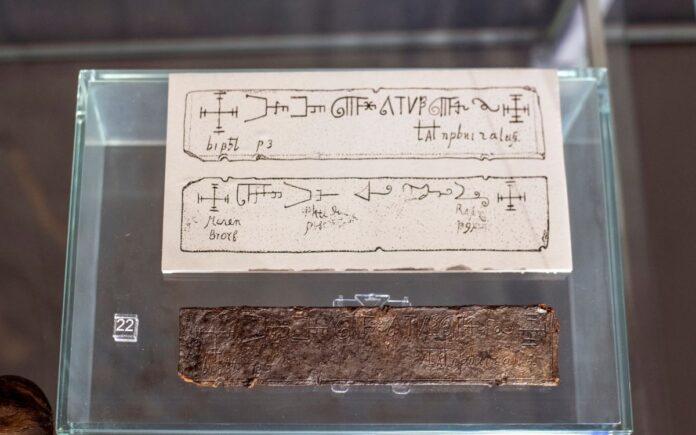
The Museum of the Grand Dukes of Lithuania in Vilnius is currently displaying a relatively new exhibit, found by archeologists 20 years ago in the area of the Old Arsenal. Using a metal detector, they expected to see an ordinary axe, but were surprised to unearth a strip of metal (19 x 4 x 0.5 cm) nailed to a wooden board. The symbols inscribed in the metal have never been seen before by Lithuanian archeologists.
Scholars hoped to find analogous or similar symbols, yet their search was fruitless, although it was determined that the inscriptions were not random. Linguists initially thought the language might be ancient Greek, but have been unable to decipher the plaque. A portion of the writing could be translated as Algirdos Basileus, meaning “Algirdas the king”, but those letters are only similar to Greek and have several ciphers missing or blended, so the translation may be approximate. According to the director of the Museum’s Archeology and Architecture Department Gintaras Striška, scholars have shelved the mystery for the time being.
The Grand Duke Algirdas who is possibly mentioned on the leaden plaque reigned over Lithuania from 1345 until 1377. The word basileus refers to the emperor of Byzantium, yet Algirdas had no such title. However, in a letter written by Algirdas to the patriarch of Constantinople, he referred to himself as basileus, said Striška, to show that his sovereignty was equal to that of the emperor.
The plaque is also unusual in that it was nailed to a piece of wood barely 3 millimetres thick. The base may have been larger, but the wood beneath was preserved by the lead.
Scholars believe that the inscription was made by several individuals due to the physical differences between the upper and lower lines, and could be in more than one language.
Museum visitors having any ideas or facts as to the origins of the text are invited to submit their theories.





























